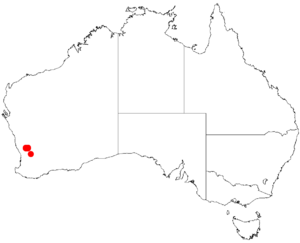Acacia dura facts for kids
Quick facts for kids Acacia dura |
|
|---|---|
| Conservation status | |
| Scientific classification | |
| Genus: |
Acacia
|
| Species: |
dura
|
 |
|
| Occurrence data from AVH | |
The Acacia dura is a type of shrub that belongs to the Acacia family. It is special because it grows naturally only in the southwestern part of Australia. This means it is endemic to that area.
Contents
About the Acacia dura Shrub
This shrub is usually quite bushy and grows to be about 0.6 to 1.6 meters (2 to 5 feet) tall. Its branches are smooth and have a ribbed look, colored grey-green to blue-green.
What are Phyllodes?
Like many Acacia plants, the Acacia dura has phyllodes instead of true leaves. Phyllodes are flattened leaf stalks that look and act like leaves. They are evergreen, meaning they stay green all year. These phyllodes stand upright and are narrow, shaped like a line or a flattened spear. They are about 2.5 to 4 centimeters long and 2 to 4 millimeters wide. The phyllodes are thick, stiff, and grey-green, with six noticeable raised lines on them.
Flowers of Acacia dura
The Acacia dura blooms in August. When it flowers, it produces bright yellow flowers.
How Acacia dura Got Its Name
The first official description of this plant was made by a botanist named George Bentham. He described it in 1855. Later, in 2003, another botanist named Leslie Pedley reclassified it. However, in 2006, it was moved back into the Acacia genus. The very first plant sample, called the type specimen, was collected by James Drummond.
Where Acacia dura Grows
This shrub is found naturally in a part of Western Australia called the Wheatbelt region. It prefers to grow in sandy or sandy-loamy soils. Often, these soils are found over or near areas with laterite, which is a type of soil and rock.
Specific Locations
The Acacia dura's natural home is quite small. It grows in the area between Wongan Hills and Piawaning. You can find it in sandy heathland areas. It often grows alongside another plant called Melaleuca uncinata.


